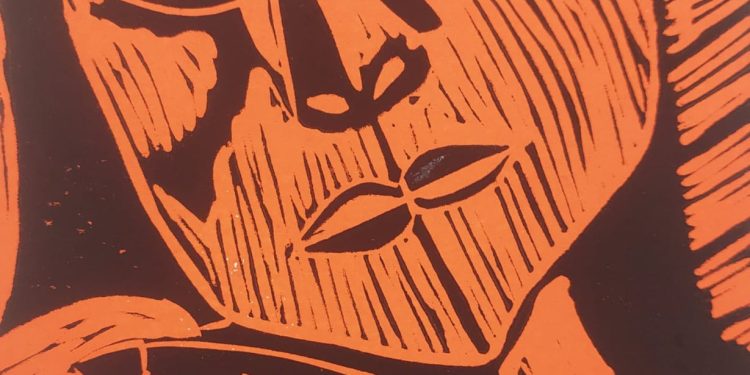A Tear Carved in Wood: An Analytical Reading of The Crying Woman by Artist and Poet Tanja Ajtic
Written by the Lebanese-Brazilian poet and translator Taghrid Bou Merhi
When poetry meets visual art, wood transforms into a page, and the chisel becomes a pen that sculpts and crystallizes emotions. This is precisely what the Serbian poet and visual artist Tanja Ajtic offers in her deeply expressive work The Weeping Woman. It is not a painted image, but an engraved one, where sorrow is etched with sharp lines, and tears manifest through silent eyes that speak volumes beyond weeping.
Her choice of woodcut technique is not a mere artistic decision, but rather an expressive stance infused with symbolic dimensions and a visual philosophy that portrays grief as something permanent impossible to erase. Every stroke of the chisel conveys buried pain, every carved line is a wound, and each darkened space absorbs memories and suffering.
Though the color palette is limited to black and orange, this visual restriction opens wide the door to interpretation. Black floods the background dense, like the silence of mourning or a memory that refuses to fade. Meanwhile, orange typically associated with warmth, becomes here a dim inner flame, a fire that burns quietly deep within the soul.
The carved face appears large, imposing, like a stone witness to eternal sorrow. Her wide-open eyes do not weep, but narrate the story of thousands of dried tears. The vertical lines on her face resemble the psychological scars of time, the imprints of a merciless heaviness, or the marks of a soul worn down by waiting.
Her mouth is closed, tight, as if sealed by a scream choked by the weight of days. The hand raised near her face is also tense, the fingers curled in a gesture that suggests inner turmoil, grasping for lost warmth, attempting to restore balance, or perhaps trying simply to hold together what remains of herself.
This sorrow doesn’t flow, it remains still, deeply settled within features meticulously carved. The engraving is not just a technique, but a visual philosophy that compresses years of pain into layers of wood. Every line stands as a testament to unforgettable agony. Ajtic does not display pain, she transforms it into a visual thought, into sorrow that is lived, not illustrated.
This artwork depicts a moment beyond tears, a state where crying is no longer useful, where pain becomes part of the being itself. Just as tree rings form over time, the woman’s emotions accumulate in the wood, becoming part of its internal structure.
When compared to Picasso’s famous Weeping Woman (1937), the contrast is striking. Picasso portrays suffering in a loud and fragmented way, while Ajtic weaves a silence heavy with grief. Picasso’s tears scream a political message, whereas Ajtic reveals an internal, human, almost prayer-like sorrow whispered in the darkness. His depiction is loud, fractured, and dramatic; hers is internal, spiritual, feminine, and profoundly human.
The woodcut technique aligns seamlessly with the meaning the artwork conveys: grief, when deeply rooted, does not merely pass through us, it reshapes us. This woman is not surrounded by sorrow, she is sculpted by it, imprinted into the wood as if she were born to embody pain. She has become the tear itself.
This is not simply a visual composition, it is a silent poem engraved in contrast, one that demands from the viewer a moment of stillness, reflection, and feeling. The absence of literal tears makes the emotional impact even more powerful; this woman has cried until her tears dried up, and her face transformed into an eternal image of sorrow that needs no explanation.
In this way, Tanja Ajtic turns wood into a mirror of the soul and transforms the artwork into a poem engraved with emotion, one that tells us:
“I have cried until my face became the mirror of my sorrow.”
دمعة محفورة في الخشب: قراءة تحليلية في لوحة “المرأة الباكية” للفنانة والشاعرة تانيا آشتيك
كتبتها الشاعرة والمترجمة اللبنانية البرازيلية تغريد بو مرعي
حين يلتقي الشعر بالفن البصري، يصبح الخشب صفحة، والإزميل قلمًا ينقش الأحاسيس ويبلورها. وهذا تمامًا ما تقدّمه لنا الشاعرة والفنانة الصربية تانجا آشتيك في عملها التعبيري العميق “المرأة الباكية”. إنها لوحة محفورة، حيث الحزن يُنقش بخطوط حادة، والدموع تتجلّى من خلال نظرات صامتة تنطق بما هو أعمق من البكاء.
اختيارها لتقنية الحفر على الخشب ليس مجرد قرار فني، بل موقف تعبيري يحمل أبعادًا رمزية، وفلسفة فنية تعبّر عن الحزن كشيء دائم لا يُمحى.
كل ضربة أزميل تنقل وجعًا دفينًا، وكل خط محفور هو جرح، يحمل أثرًا حيًّا لحالة وجدانية متأصلة، وكل مساحة سوداء هي امتصاصًا للذكريات والألم.
الألوان محدودة إلى الأسود والبرتقالي، غير أن هذا التقييد البصري يفتح بابًا واسعًا للتأويل. الأسود يغمر الخلفية، كثيفًا كصمت الحداد أو ذاكرة لا تموت. أما البرتقالي، الذي عادةً ما يرمز للدفء، فقد تحوّل هنا إلى لهب داخلي خافت، نار تشتعل بصمت في عمق الروح.
الوجه المحفور يبدو ضخمًا، مهيبًا، وكأنه شاهد حجري على ألم أزلي. العينان مفتوحتان بشكل لافت، لا تبكيان، لكنهما تحكيان عن آلاف الدموع التي جفّت. الخطوط الرأسية في وجهها تبدو كأنها تجاعيد الندوب النفسية، آثار لزمن دهسها بثقله دون رحمة، أو ندوب روح أنهكها الانتظار.
الفم مغلق، مشدود، كأنه ختم على صرخة خنقتها الأيام. اليد القريبة من الوجه مشدودة كذلك، أصابعها منكمشة في حركة تنم عن توتر داخلي، وكأنها تحاول الإمساك بظل دفء قديم أو استعادة توازن مفقود، أو ربما تحاول أن تُبقي ما تبقى منها متماسكًا.
هذا الحزن لا يتحرك، لا يتدفق، بل يستقر داخل ملامح محفورة بإتقان، ويتحول إلى هوية. النحت هنا ليس مجرد تقنية، بل فلسفة في التعبير، تختزل سنوات من الألم في طبقات من الخشب.
كل خط هو شهادة على وجع لا يُنسى، وتانجا لا تستعرض الألم، إنما تحوله إلى فلسفة بصرية، إلى حزن يُعاش.
اللوحة تُصوّر حالة ما بعد البكاء، اللحظة التي لا تعود فيها الدموع مجدية، حين يتحول الألم إلى جزء من الكيان. كما تتشكل حلقات الشجرة بفعل الزمن، تتراكم مشاعر المرأة في خشب اللوحة، وتُصبح جزءًا من بنيتها الداخلية.
وعند مقارنة هذه العمل بلوحة بيكاسو الشهيرة “المرأة الباكية” (1937)، نرى تباينًا واضحًا. بيكاسو يصور الألم بشكل صاخب وممزق، بينما تنسج تانجا ملامح الصمت المثقل بالحزن. في حين تتحول دموع بيكاسو إلى صرخة سياسية، تكشف تانجا عن معاناة إنسانية داخلية، أشبه بصلاة خافتة في عتمة الروح، فبيكاسو يرسم دمعة سياسية، صاخبة، مشوهة. أما تانجا، فتقدم دمعة داخلية، روحانية، أنثوية، وإنسانية بامتياز.
تقنية الحفر على الخشب تتناغم تمامًا مع المعنى الذي تحمله اللوحة: فالحزن، حين يتجذر فينا، لا يعبر عنا فقط، إنما يكوِّننا من جديد. المرأة هنا مُشكّلة بالحزن، مطبوعة في عمق الخشب كأنها وجدت لتكون تجسيدًا للألم، فصارت هي نفسها دمعة.
العمل ليس مجرد لوحة، العمل قصيدة صامتة محفورة في التضاد اللوني، تفرض على المُشاهد أن يصمت، يتأمل، ويشعر. غياب الدموع الواضحة يزيد من قوة التأثير؛ فالمرأة قد بكت حتى جفّت، وتحوّل وجهها إلى صورة خالدة لحزن لا يحتاج إلى شرح.
هكذا تُحوِّل تانيا الخشب إلى مرآة للوجدان، وتجعل من اللوحة قصيدة محفورة بالمشاعر، تقول لنا فيها: “لقد بكيت حتى صار وجهي مرآة لحزني.”





















